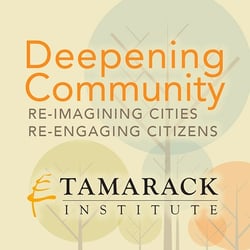“In every community there is work to be done. In every nation, there are wounds to heal. In every heart there is the power to do it.” - Marianne Williamson
Tamarack’s Deepening Community Practice Area is a learning community for people interested in neighbourhood-based change and those eager to deepen their understanding of the unique role citizens can play in leading positive community change. It is an online space to meet, share resources and learn together.
The idea of community resilience has been emerging more often with members of the Deepening Community Practice Area. So, recently, I dove more deeply into this concept wanting to understand why it was capturing attention. I wrote the article, The Case for Cultivating Community Resilience, to share some of what I discovered. The article was released at Tamarack’s Community Change Institute in September and I’m happy to summarize highlights from that article here.
Community resilience is most often defined as a community’s ability to bounce back after a crisis or disaster. And while that is true, I discovered that there is a second, equally important, dimension which is often overlooked. That is the capacity of a community to proactively respond to opportunities and enhance its well-being even during times of stress. Understanding what and how community resilience is nurtured and sustained is particularly important today as communities are impacted by an array of complex issues including: the effects of climate change; deteriorating infrastructure; growing levels of debt; rising inequality; and growing rates of isolation and loneliness in people all ages. The concept of community resilience is particularly useful in the face of these complex issues because it offers a lens that captures the dynamic nature of communities as living systems and emphasizes their capacity to creatively adapt to the changing environment surrounding them.
What I found particularly inspiring is the rich body of concrete, tangible actions that communities can take to strengthen their resilience. Intentionally cultivating a focus on community assets and resources and deliberately engaging community members to share leadership and trust one another enough to embrace collaborative action are two of the most fundamental actions.
Place plays a significant role in the creation and shaping of community resilience. In fact, adopting a “place-based” rather than “issues-based” approach can encourage action to unfold at a very local level, which reminds us that promising solutions and strategies to many global issues, paradoxically, are found at the local level. Community engagement and leadership are also essential to nurturing community resilience and translating creative ideas into reality.
Finally, community resilience and the path to increasing it often involves not just doing different things, but also being willing to do things differently. For local organizations and governments, embracing resilience may require re-examining how they think about their relationships with communities. For citizens it requires moving beyond viewing ourselves simply as voters and taxpayers and to recognize that strong communities are ones where the skills, talents and leadership of residents is known, recognized and connected.
Learn More:
- Download the full article: The Case for Cultivating Community Resilience
- Join Paul Born for Deepening Community for Collective Impact a 1-day workshop in Red Deer, Nov. 14th and Waterloo November 30th, 2016
- Visit and join Tamarack’s Deepening Community Practice area at www.deepeningcommunity.ca






